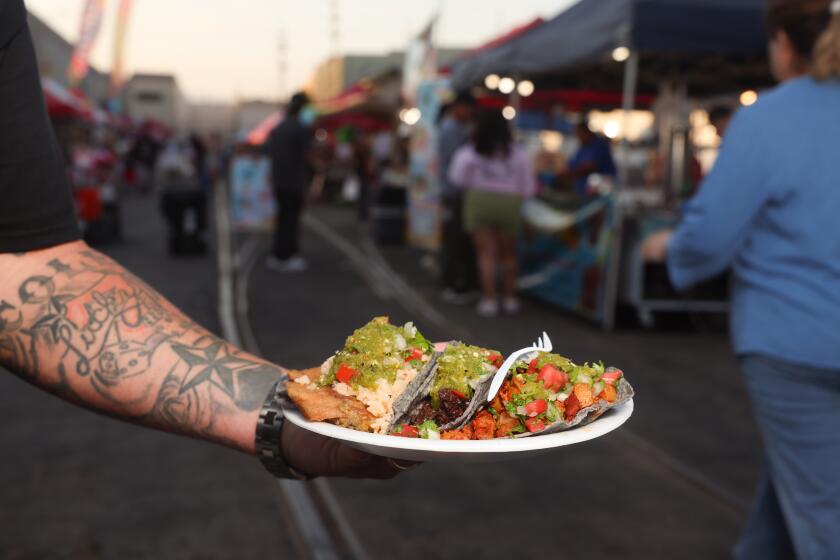The 5th Quarter : The Innard Limits: Meats You’ve Been Missing
Why are these vital organs of the animal not generally eaten? One reason, certainly, is precisely that they are vital. They are associated with urine, blood, excrement and the gastric functions of the animal. The average American clutches his hot dog and turns from them in horror. Verily, ignorance is bliss. --Angelo Pellegrini, “The Unprejudiced Palate”
Anthropologist Marvin Harris, paraphrasing Claude Levi-Strauss, proposes the idea of foods that are “good to think” and foods that are “bad to think.” For most Americans, “the Fifth Quarter”--the parts remaining after the steaks and chops and hamburger are portioned out--is bad to think.
Most of us don’t want to think about lamb tongues or veal kidneys or whole pig heads, and we certainly don’t want to eat them. For many, a confrontation with, say, a tripe sandwich is like staring at a Diane Arbus photograph for an uncomfortably long time. It’s hardcore vegetarian pornography.
“Americans are an awfully squeamish lot,” La Toque chef/owner Ken Frank said Friday. “I mean, everyone’s just so paranoid about food.”
Few of us are used to dealing with the sources of even our best-loved foods. We pick up the steaks we buy, the milk we drink and the frozen diet dinners we microwave in sterile supermarkets, far from the cattle ranches and wheat fields and factories where our food is processed. We don’t stop to consider that other cultures consider our habits odd, that milk, as Marvin Harris puts it, is thought of by some Asians as a “foul-smelling glandular secretion.”
But Americans are not alone. Butchers have historically done the dirty work for society, even in open-minded Europe. “You could even say,” wrote Pierre Gascar in “Les Bouchers,” “that the function of the butcher in human society is to keep individuals from facing the brutal reality of their needs.”
Still, we have this reputation . . .
“In American cooking,” food author Elizabeth David once wrote, “everything that can be thrown away is thrown away.”
“Americans are the most neurotic people in the world,” chef/owner Lydia Shire of Boston’s Biba Food Hall recently told a trade magazine. “They’re scared of anything slightly foreign to them.”
The Americans who eat at Shire’s Biba Food Hall, however, must be an exception: She devotes a whole section of her menu to offal.
“We’ve served all sorts of things,” Shire said this week over the phone. “We make a tripe soup that people have loved, and veal heart: delicious . Right now we’re making these wonderful fresh corn tamales and serving them with pork jowls, which are kind of like bacon. And, of course, we make our own blood sausage. We blanch and boil them and then deep-fry them so they get crispy on the outside. Sometimes we serve them with pureed parsnips and fried parsnip chips. Doesn’t that sound good?”
Shire’s menu descriptions are written to make people hungry: “Great macaroni and cheese with braised oxtail pieces” . . . “Thin slice of veal kidney with rasher of bacon, hot foaming mustard and parsley crumbs.”
But is there anything Shire wouldn’t eat?
“Let’s see,” Shire said, pausing for a long moment. “Um, not really. Once I was on a mountain top in Columbia and ate fried intestines with all the goop still inside--that freaks some people out. But hey, they’re really good. They put the intestines in a little casserole and cook them in an outdoor wood-burning oven. They’re fried in oil and come out really crispy; inside, they’re good and creamy.”
But the most adventurous eaters sometimes waver too. Even Calvin Schwabe, author of the perhaps excessively thorough “Unmentionable Cuisine,” sounds, well, squeamish when he discusses stuffed calf’s eyes: “I offer, hesitantly, two variations on a more exotic French dish which I confess not to have tried. It would probably make excellent Halloween party fare.”
It should be noted, however, that after the book’s publication, the now-defunct Cuisine magazine reported on a 1984 dinner of unmentionables that Schwabe hosted. On the menu: lamb’s eyes baked with truffles and shiitake mushrooms. Reported the correspondent: “They were almost nutty in texture and not in the least repugnant.”
Those who are not repelled by offal are often attracted to it for its exotic nature. It’s lusty food. Because the majority of us were raised on hamburgers and hot dogs and generally bland food, we find it almost illicit--especially when the places that serve the stuff are either divey ethnic places, pricey French and Italian restaurants . . . or in other countries.
In Rome, in the old slaughterhouse quarter, the century-old restaurant Checchino is totally devoted to the fifth quarter. People come from around the world to eat rigatoni with small intestine or lamb testicles stewed with artichokes. Tripe stew seems relatively dull here.
“You talk to people after they eat your food, the few who actually like offal, and they are so pleased,” Patina chef/owner Joachim Splichal told The Times on Monday. He serves kidney (stuffed with diced vegetables and rolled in caul fat, then seared and served on a bed of spinach, with mustard sauce and some garlic on the side) and cock’s combs (on pearl onions and curly cabbage in a red wine sauce with toasted croutons). “They say, ‘I can’t believe you have this!’ It’s like the discovery of a cult.”
(The cultish consequences of eating too much offal are those of a gastronome: gout, which results from high levels of uric acid triggered by meat organs and high cholesterol. Offal devotees are quick to point out, however, that offal is high in vitamins and minerals.)
In the upper tiers of the restaurant community, at least, the cult has been slowly growing. As we move away from the minimalism of California cuisine toward more rustic cooking, the robust flavors of organ meats may gain an even larger audience.
In Los Angeles, the offal revival may have started 20 years ago with the late Jean Bertranou, who spearheaded the French-California cuisine movement at L’Ermitage and inspired a generation of young chefs. Before Bertranou, it was almost impossible to find fresh herbs, flavorful ducks . . . and quality offal. Outside Chinatown, anyway. “The first person who ever asked me for veal sweetbreads was Jean Bertranou,” said Harvey Gussman, who supplies meat for many of L.A.’s best restaurants. “No one ever wanted them before. I sold them to him for 90 cents a pound. Now they go for $6, $7 dollars a pound. It’s ridiculous.” Superior Meat in Beverly Hills sells between 180 and 200 pounds of sweetbreads a week. “That’s a lot,” said manager Tino Casillas. “Each sweetbread weighs only 10 or 12 ounces.”
If sweetbreads have caught on fairly quickly, even Bertranou, according to Gussman, had trouble selling kidneys.
“Kidneys and brains seem to be the most problematic,” Ken Frank said. “I mean brains look like brains and kidneys have a somewhat strong flavor.”
But Joachim Splichal feels that brains have been easier to sell lately. “People accepted them,” he said, “because they have a basic, plain delicate flavor.” (A few cookbooks compare the taste of brains to sweetbreads.)
The kidneys Splichal serves sell, but they are relatively slow movers. “We sell an average of one a day,” Splichal said. “Some days we sell four, then we have three days when we don’t sell any--you can never predict it.”
At Campanile, chef/co-owner Mark Peel does well with liver and sweetbreads, but he doesn’t feel he could sell kidneys, which he loves. “They’re so good if you do them right,” he said.
Tulipe’s Roland Gilbert and Maurice Peguet do occasionally serve kidney, and it sells fairly well, but their biggest success has been with a dish of brains, sweetbreads, snails and cow foot, cooked together with a bit of ginger, some garlic and shallots, then wrapped in caul fat and sauteed. It’s finished with a little stock and garnished with tomato and parsley. For many, it’s one of the most exciting dishes offered in Los Angeles. What’s more, it sells well.
“We tried it as a special,” Peguet said. “People kept ordering it so we put it on the menu. It’s one of our most successful dishes. Of course, it’s definitely not for everyone.”
“You really have to analyze who your customer is,” said Valentino owner Piero Selvaggio, “to figure out how aggressive and adventurous and knowledgeable he or she is. These are risky dishes.”
By carefully gauging his customers, Selvaggio has had some success with offal. “We use veal kidneys, oxtail and we make wonderful salads with brains,” he said last week. “And one of our most triumphant dishes is risotto with tongue and lentils. It’s a dish that’s helped us show people that tongue has a mild flavor.”
Lamb, veal and cow tongue are the being served more and more Los Angeles restaurants. Border Grill’s tongue stew is one of the most delicious. And the new Italian restaurant Oli Ola in Pacific Palisades serves a good tripe stew.
But if Shire had a say in the next big offal, it might be kidney. “I tell you,” she said, “if I blindfolded a bunch of people and had them taste an absolutely perfectly fresh veal kidney, grilled, with mustard and maybe bacon on top, I’m sure they would think it was terrific--I mean, kidney is nice meat.”
More to Read
Eat your way across L.A.
Get our weekly Tasting Notes newsletter for reviews, news and more.
You may occasionally receive promotional content from the Los Angeles Times.







